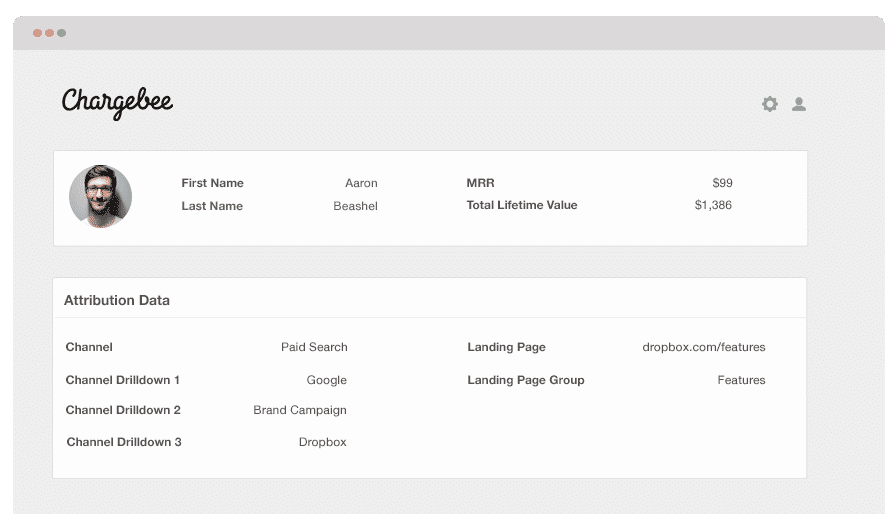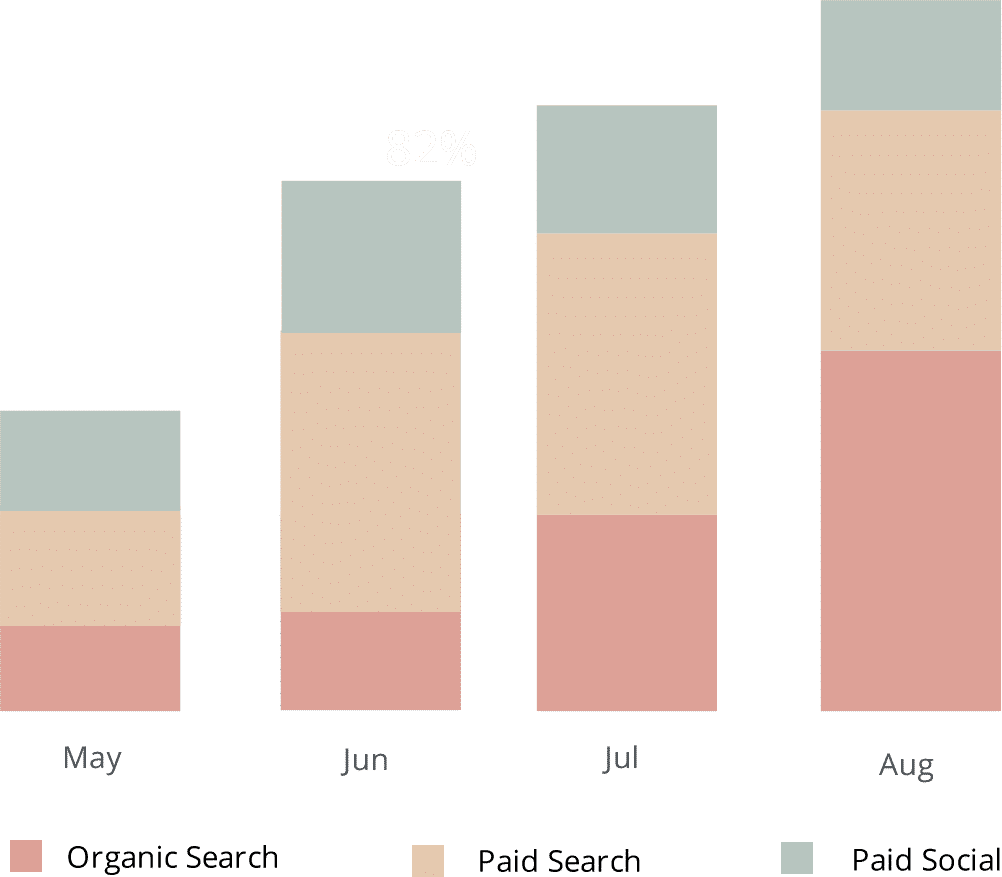4 simple steps to get UTM parameters into Chargebee
Learn how to get UTM parameters into Chargebee in 4 simple steps, so you know what marketing channels & campaigns are generating your trials, customers & recurring revenue

Chargebee is a great billing and customer management system that gives you the ability to run reports to understand more about your customers, your churn rate, ARR, MRR and more!
But, while it’s great to have these metrics, wouldn’t it be great to be able to divide it further by marketing channel or campaign?
This way, you’ll be able to understand which marketing channels to double down on and which campaigns were successful.
In order to do this, you need to them somehow pass UTM parameters and other marketing channel data into Chargebee.
In this article, we’ll show you how Attributer can help you do exactly this.
What is Attributer?
Attributer is a bit of code that you install onto your website.
When a visitor lands on your page, Attributer will do some technical behind-the-scenes work to understand where the visitor came from and assign a channel to their visit (such as Paid Search, Paid Social, Organic Search, etc.)
Attribuiter will then store that information in the visitor’s browser and when they sign up for whatever your product or service may be, Attributer will pass that channel information along with the visitor’s sign up details into Chargebee.
With this data, you can understand how many trials, customers & revenue you have generated from your different channels and campaigns (I.e. from your Google Ads or Facebook Ads).
4 steps for capturing UTM parameters in Chargebee
You can easily get UTM parameters (as well as marketing attribution data for organic channels) into Chargebee by following these 4 steps:
1. Add UTM parameters to your ads

For Attributer to be able to trace where your traffic is coming from, you need to add UTM parameters to all your ads & campaigns.
This includes ads on social media sites, such as Facebook, Instagram, LinkedIn, Twitter and more.
It also includes Paid Search ads as well as any other campaigns you may be running with media outlets and publications.
2. Attributer stores the UTM parameters in a cookie

Now, after you have installed the Attributer script onto your site, it will automatically start searching for these UTM parameters in the URL and storing them in a cookie in your visitors' browser.
3. UTM parameters are sent to Chargebee

When a visitor fills out a form on your site, for example, a signup form on your SaaS application, the UTM parameters are sent into Chargebee along with all the other user data that has been inputted, such as the user’s first name, last name, email address and whatever other details you requested in the form.
This information can be sent to Chargebee in two ways:
- Hidden fields in forms - You can add hidden fields to your forms and Attributer will write the data to them. Once the form is submitted, this data is passed to Chargebee with any other information submitted in the form.
- Retrieved from the cookie - A simple line of Javascript can be added to your form so that the UTM parameters are captured from the Attributer cookie and can then be passed into Chargebee. This is especially useful if you give your users the options to ‘Signup with Google’ or ‘Signup with Facebook. where there's no form that you can add hidden fields to.
4. Run reports in Chargebee

Now that Chargebee has both the user’s information as well as the marketing and UTM data, you can run even more detailed reports!
These reports will break down your various subscription metrics based on the marketing channel and/or campaign the customer came through.
These include:
- New Trials added each month by Channel or Campaign
- Trial to Customer conversion rate by Channel or Campaign
- New Customers added each month by Channel or Campaign
- New MRR added each month by Channel or Campaign
- New ARR added each month by Channel or Campaign
- ARPU by Channel or Campaign
- Lifetime Value by Channel or Campaign
- Customer Churn Rate by Channel or Campaign
- MRR Churn Rate by Channel or Campaign
- And more!
Why using Attributer is better than capturing raw UTM parameters
Yes, there are other tools out there that will help you capture raw UTM parameters and pass them into Chargebee. Alternatively, you may have your developers create a script to do it.
But using Attributer gives you many other perks. Including:
1. Captures all traffic
Even if UTM parameters aren't present, Attributer can still capture information about how that visitor found you and pass it to Chargebee. This includes channels like Organic Search, Organic Social, Referral, Direct, etc. All of this can be captured and stored for your marketing reports, and not just paid ads!
2. Remembers the data across multiple page views and sessions
For most other UTM capture software on the market, the UTM has to be on the same page where the user signs up for your product or service in order for the marketing data to be successfully passed through to Chargebee.
But what if the page they signed up for for your product is different to the landing page of your ad?
Let's say a user clicks on your Google Ads and lands on the landing page that you set up for that ad campaign. If they click the ‘Start Free Trial' button and are redirected to another page to sign up for the product this would then mean that the UTM parameters are lost.
But Attributer does things a bit differently. We store the UTM parameters in a cookie in the user's browser, meaning the original UTM parameters are never lost even when the user signs up on a page different to the ad landing page.
3. Provides cleaner data
If you're familiar with UTM parameters, you also know how messy the data can get, especially if your ads have been managed by different individuals or agencies over time.
Let's say some of your Facebook Ad campaigns are tagged with UTM_Source=Facebook (capitalized), others with UTM_Source=facebook (uncapitalized), and others with UTM_Source=fb.
If you were to use other UTM tools on the market that simply capture the raw UTM parameters, this would show up as 3 different sources in Chargebee and make it difficult to run reports.
But Attributer has built-in logic to tackle these inconsistencies and will categorise everything as 'Paid Social' regardless.
4. Captures landing page data as well
We all know how much effort goes into creating those content pieces and blogs for your site, but the thing is, without any idea of how many signups and customers are being generated from your blog, you don't know whether the time and energy you pour into their creation are actually worthwhile.
But with Attributer can capture information like the landing page (e.g. attributer.io/blog/capture-utm-parameters) as well as landing page category (e.g. blog), meaning you can see how well your content marketing efforts are performing as well.
Wrap up
If you're wanting to get UTM parameters into Chargebee then Attributer is what you're looking for.
While we understand that there are other UTM capturing tools on the market, Attributer differentiates itself by automatically cleaning up inconsistent data, capturing landing page data, and more!
The best part is that Attributer is free to get started, so start your free 14-day trial today!
Get Started For Free
Start your 14-day free trial of Attributer today!

About the Author
Aaron Beashel is the founder of Attributer and has over 15 years of experience in marketing & analytics. He is a recognized expert in the subject and has written articles for leading websites such as Hubspot, Zapier, Search Engine Journal, Buffer, Unbounce & more. Learn more about Aaron here.
